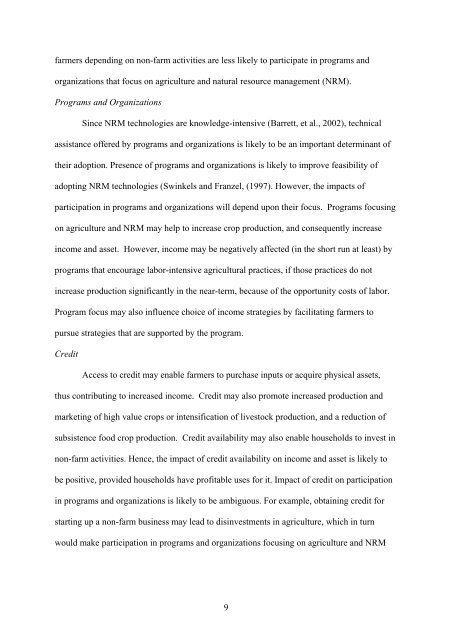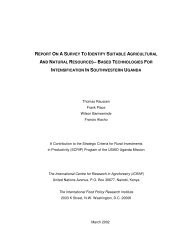community and household-level income & asset status baseline
community and household-level income & asset status baseline
community and household-level income & asset status baseline
You also want an ePaper? Increase the reach of your titles
YUMPU automatically turns print PDFs into web optimized ePapers that Google loves.
farmers depending on non-farm activities are less likely to participate in programs <strong>and</strong><br />
organizations that focus on agriculture <strong>and</strong> natural resource management (NRM).<br />
Programs <strong>and</strong> Organizations<br />
Since NRM technologies are knowledge-intensive (Barrett, et al., 2002), technical<br />
assistance offered by programs <strong>and</strong> organizations is likely to be an important determinant of<br />
their adoption. Presence of programs <strong>and</strong> organizations is likely to improve feasibility of<br />
adopting NRM technologies (Swinkels <strong>and</strong> Franzel, (1997). However, the impacts of<br />
participation in programs <strong>and</strong> organizations will depend upon their focus. Programs focusing<br />
on agriculture <strong>and</strong> NRM may help to increase crop production, <strong>and</strong> consequently increase<br />
<strong>income</strong> <strong>and</strong> <strong>asset</strong>. However, <strong>income</strong> may be negatively affected (in the short run at least) by<br />
programs that encourage labor-intensive agricultural practices, if those practices do not<br />
increase production significantly in the near-term, because of the opportunity costs of labor.<br />
Program focus may also influence choice of <strong>income</strong> strategies by facilitating farmers to<br />
pursue strategies that are supported by the program.<br />
Credit<br />
Access to credit may enable farmers to purchase inputs or acquire physical <strong>asset</strong>s,<br />
thus contributing to increased <strong>income</strong>. Credit may also promote increased production <strong>and</strong><br />
marketing of high value crops or intensification of livestock production, <strong>and</strong> a reduction of<br />
subsistence food crop production. Credit availability may also enable <strong>household</strong>s to invest in<br />
non-farm activities. Hence, the impact of credit availability on <strong>income</strong> <strong>and</strong> <strong>asset</strong> is likely to<br />
be positive, provided <strong>household</strong>s have profitable uses for it. Impact of credit on participation<br />
in programs <strong>and</strong> organizations is likely to be ambiguous. For example, obtaining credit for<br />
starting up a non-farm business may lead to disinvestments in agriculture, which in turn<br />
would make participation in programs <strong>and</strong> organizations focusing on agriculture <strong>and</strong> NRM<br />
9

















